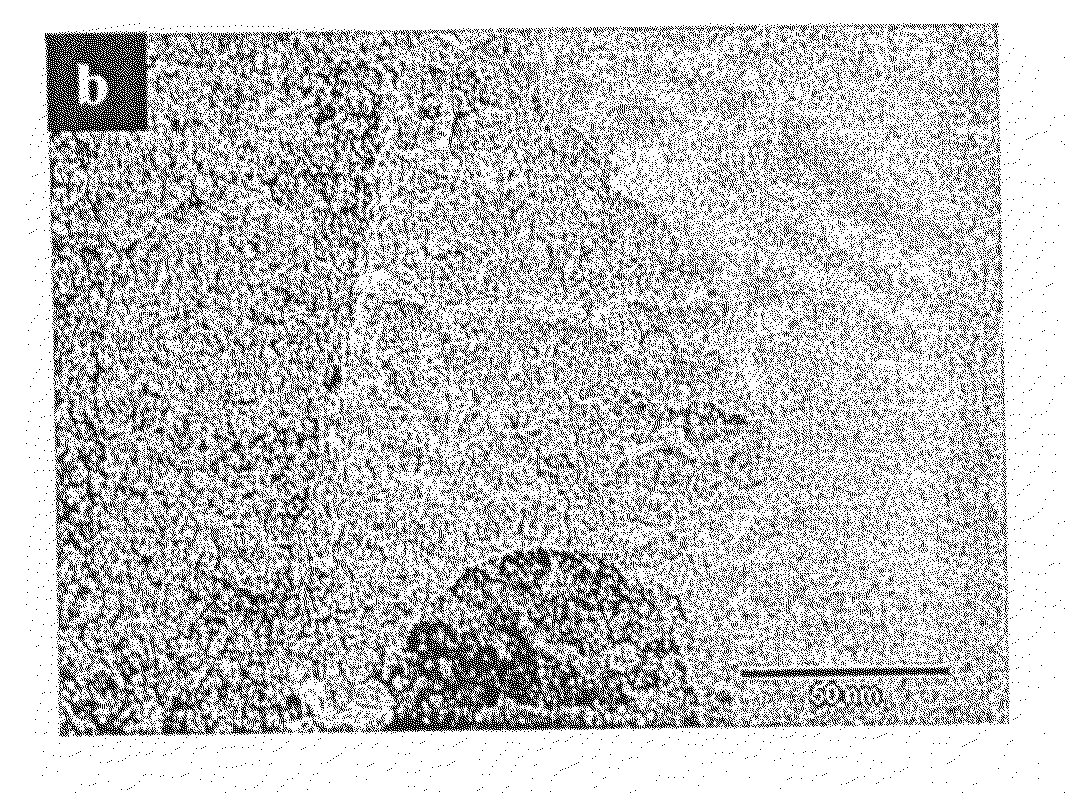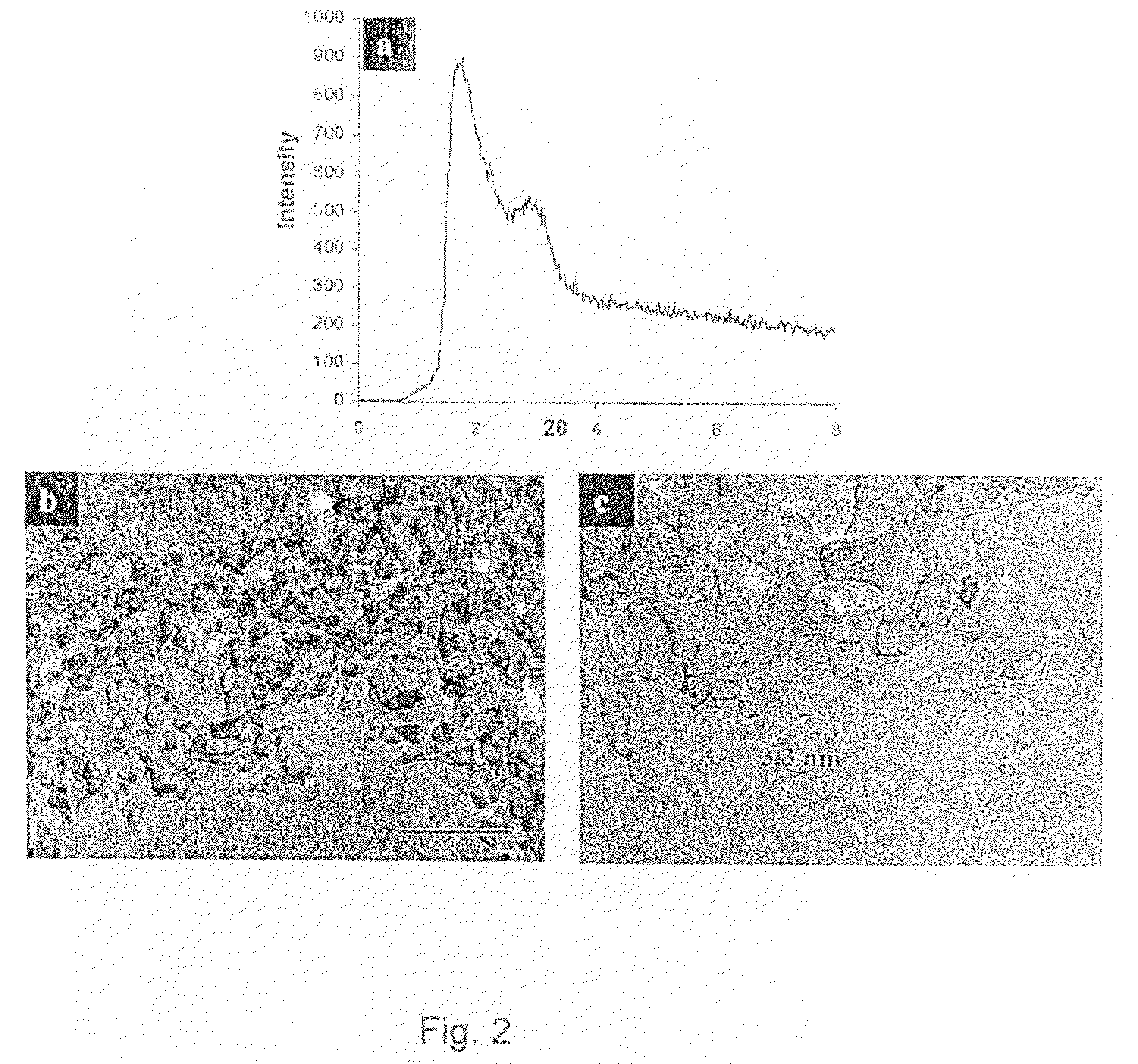Method for manufacturing a nanoporous framework and a nanoporous framework thus produced
a nanoporous framework and nanoporous technology, which is applied in the direction of physical/chemical process catalysts, tin oxides, silicon compounds, etc., can solve the problems of unsuitable many-catalytic application applications, high post-synthetic treatment cost, and low catalyst yield
- Summary
- Abstract
- Description
- Claims
- Application Information
AI Technical Summary
Benefits of technology
Problems solved by technology
Method used
Image
Examples
example 1
[0127]A Gallium Laureate water solution, containing the monodentate soap, was prepared and heated in a closed polypropylene container to 90° C. for 10 hours to induce the complete dissolution of the soap. The pH of the liquor was adjusted to 10 with tetramethyl ammonium hydroxide solution (25% TMAOH in methanol). To this solution tetraethyl orthosilicate was added at 60° C. under constant stirring (300 rpm). A synthesis gel with molar ratio of 1:1000: 4:1 (Gallium Laurate: water: tetramethyl ammonium hydroxide: Tetraethyl orthosilicate) was formed. The synthesis gel was transferred to a Teflon lined stainless steel autoclave and placed in an oven at 120° C. for 24 hours to encourage condensation of the silica, forming the silica / metal soap composite.
[0128]The composite was then heated at 550° C. under flowing oxygen, in order to remove the organic soap, resulting in a porous silicate / gallium oxide composite.
example 2
[0129]A Nickel palmitate water solution, containing the monodentate soap, was prepared and heated in a closed polypropylene container to 90° C. for 10 hours to induce the complete dissolution of the soap. The pH of the clear solution was controlled to 9 by addition of Sodium Hydroxide pellets. To this solution, tetraethyl orthosilicate was slowly added at 80° C. whilst stirring before the resulting synthesis gel was transferred into a Teflon lined stainless steel autoclave and placed in an oven at 120° C. for 24 hours to encourage condensation of the silica, forming the silica / metal soap composite. The synthesis gel had a final molar ratio of 1:1000: 12.5:1 (Nickel Laurate: water: tetramethyl ammonium hydroxide: Tetraethyl orthosilicate). At this stage the silicate / nickel oxide (NiO) composite is green in colour indicating.
[0130]The composite was then heated at 550° C. under flowing oxygen, in order to remove the organic soap, resulting in a black porous silicate / nickel oxide (Ni2O3...
example 3
[0132]An Erbium laurate water solution was prepared and warmed in a closed polypropylene container to 70° C. for 10 hours to induce the complete dissolution of the soap. To this solution Trimethyl ammonium hydroxide was added, and the solution was stirred for a further 2 hours. Ammonium propyl silane was added followed by tetraethyl orthosilicate. The synthesis gel had a final molar ratio of 1:1000: 12.5:1 (Erbium Laurate: water: tetramethyl ammonium hydroxide: Tetraethyl orthosilicate). The synthesis gel was treated hydrothermally, at 110° C. for 3 days before it was filtered and dried at RT under static air conditions. The alkyl chains of the soap were removed by calcination at 500° C., under flowing oxygen. The low angle XRD pattern, FIG. 2a, contains an intense diffraction peak owing to ordering at the mesoscale. The wide-angle diffraction intensities arise from the formation of a crystalline metal oxide phase. HRTEM images, FIGS. 2b and c, confirm the porosity of the sample and...
PUM
| Property | Measurement | Unit |
|---|---|---|
| thickness | aaaaa | aaaaa |
| temperatures | aaaaa | aaaaa |
| temperatures | aaaaa | aaaaa |
Abstract
Description
Claims
Application Information
 Login to View More
Login to View More - R&D
- Intellectual Property
- Life Sciences
- Materials
- Tech Scout
- Unparalleled Data Quality
- Higher Quality Content
- 60% Fewer Hallucinations
Browse by: Latest US Patents, China's latest patents, Technical Efficacy Thesaurus, Application Domain, Technology Topic, Popular Technical Reports.
© 2025 PatSnap. All rights reserved.Legal|Privacy policy|Modern Slavery Act Transparency Statement|Sitemap|About US| Contact US: help@patsnap.com



